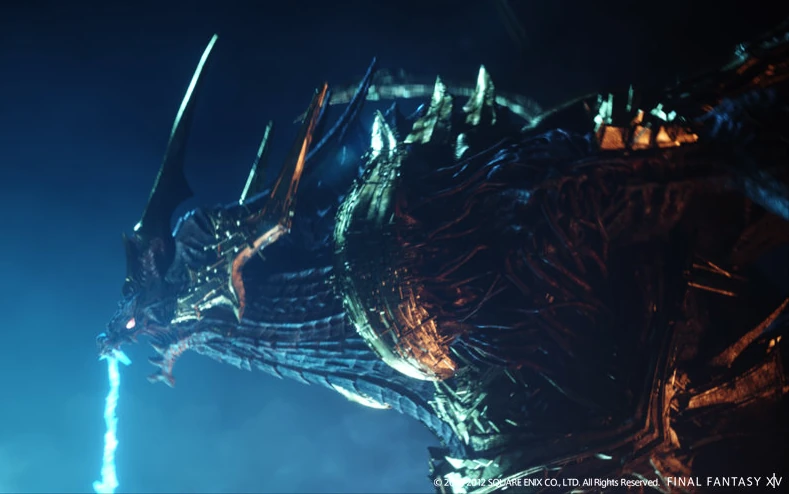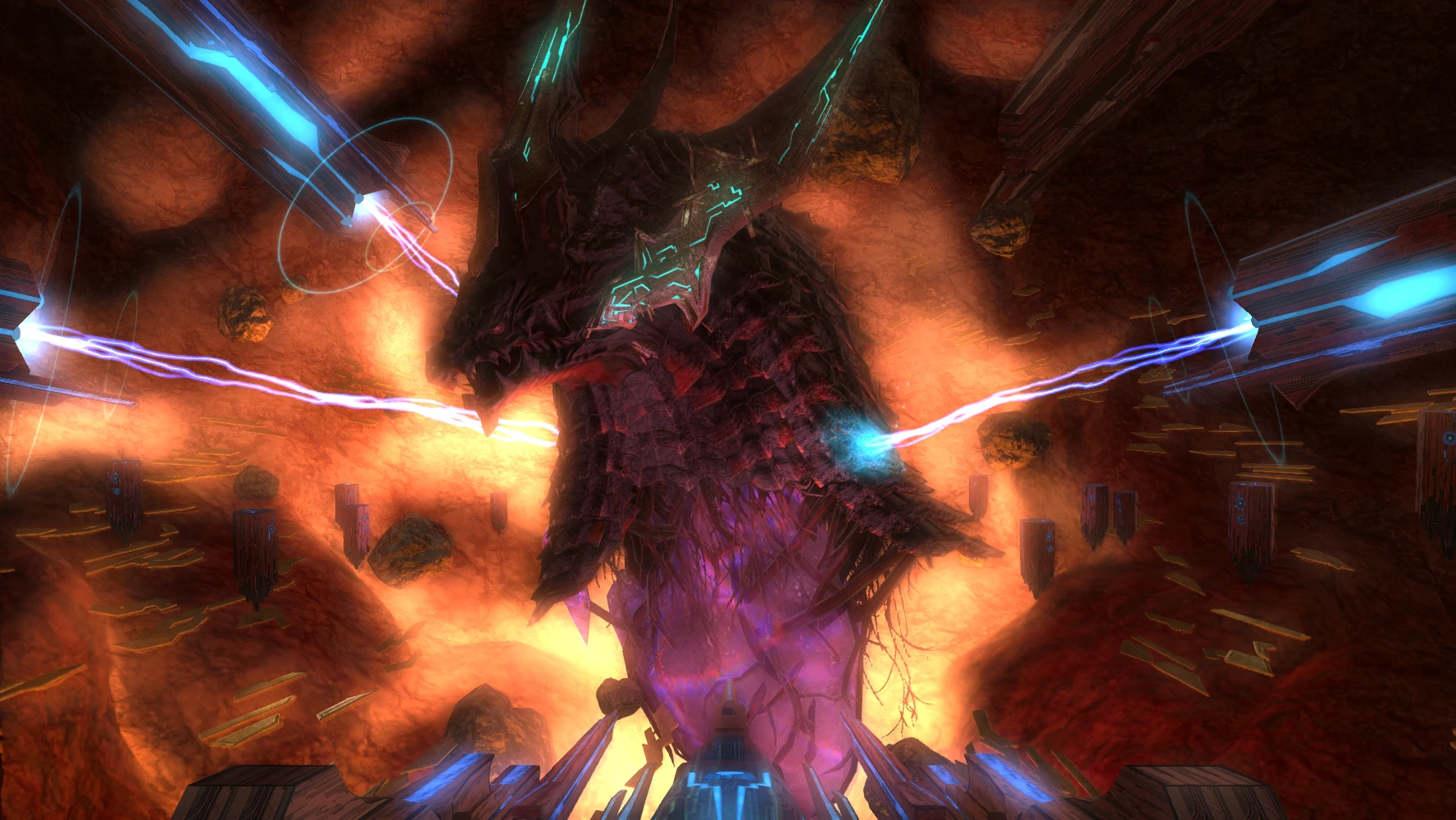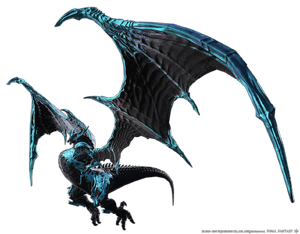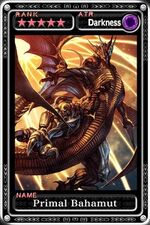Held in duress for aeons within the lesser moon, Dalamud, the elder primal Bahamut broke free of his captivity when the celestial body was wrested from the heavens to descend upon the Battle of Carteneau. Once freed, the terrible being wrought fiery destruction across the length and breadth of Eorzea, his devastating rampage marking the beginning of the Seventh Umbral Era. In the midst of the chaos, however, Bahamut was enveloped in a blinding white light and abruptly disappeared from the skies. None claim to have seen the primal in the five years since.Official site description
Bahamut [bəˈhɑː.mət, ˈbɑː.hə.mət], also known as the Dreadwyrm, is an elder primal in Final Fantasy XIV. The fall of Dalamud and the furious rampage of the elder primal was part of the Seventh Umbral Era storyline, used to explain the changes from Version 1.0 to Final Fantasy XIV: A Realm Reborn. Bahamut's final fate is later explored in the Binding Coil storyline, and more of his origins are elaborated in Final Fantasy XIV: Heavensward.
History
Originally the eldest of the first brood of Midgardsormr, Bahamut and his brood-sister Tiamat settled in the southern continent of Meracydia and founded the Meracydian horde. Bahamut perished during the twilight of the Third Astral Era while defending Meracydia from an invasion by the the reborn Allagan Emperor Xande who set about his campaign making a covenant with the Cloud of Darkness. Tricked by the Ascians, Tiamat led her remaining children in summoning a primal in the original Bahamut's image to "resurrect" him; the summoned Bahamut, however, was nothing like the original Bahamut. Despite the new "Bahamut's" efforts, the Ascians taught Xande the means to subdue the Dreadwyrm with the alien entity Omega, resulting in the primal being incarcerated in an artificial satellite called Dalamud to collect solar energy for the benefit of the Allagan Empire.
To ensure the primal would remain in place, colossal neurolinks held him in restraint while captive dragons were kept aboard the space station in stasis to keep him summoned perpetually. Having embraced nihilism while brooding over his mortality, a rebellion having begun among the people, Xande tried to summon the Cloud of Darkness to the Source by channeling the amassed energy from Bahamut into Syrcus Tower. As this exceeded its capacity the excess of energy caused a devastating earthquake that ruined the Allagan civilization and ushered the Fourth Umbral Era.
Final Fantasy XIV (version 1.0)

As eras passed, Dalamud's origins were forgotten and it became known only as "Menphina's Loyal Hound." At the end of the Sixth Astral Era, the Garlean Empire began Project Meteor under Legatus Nael van Darnus whose family inherited knowledge of Dalamud's nature and sought to bring it down to eliminate the primal threat in Eorzea. Though the Lunar Transmitter that controlled the artificial moon was destroyed, van Darnus used the spell Meteor to keep it on a descent trajectory.
As she was confronted by the adventurer atop Rivenroad, Nael exhibited a fanatical devotion to Bahamut and was bathed in the primal's power when he attempted to kill the interlopers as Nael deus Darnus. Though Nael was defeated, Dalamud's descent could not be stopped. The Archon Louisoix Leveilleur attempted to summon the Twelve to halt the calamity, using the prayers for a realm reborn.
As the Grand Companies engaged the remnants of Nael's VIIth Legion at the Carteneau Flats, Dalamud broke apart with Bahamut freed to exact his wrath on the realm. Though the ritual failed, watching the primal terraform much of Eorzea through his destructive power, Louisoix was infused with enough aether to defeat Bahamut single-handedly.
Final Fantasy XIV: A Realm Reborn

As no one witnessed Bahamut's defeat, people assumed the primal disappeared without a trace in the aftermath of the chaos. After the defeat of Gaius van Baelsar and the declaration of the Seventh Astral Era, the adventurer is directed to the Binding Coil of Bahamut where the elder primal's heavily damaged body ended up while Louisoix, who had transcended his mortal existence into the primal Phoenix, reveals the events of the Seventh Umbral Era.
The captive dragons of Meracydia within the Coil are subjected to unending agony to maintain the elder primal's physical form, and Bahamut is slowly regenerating to resume his attack on humanity. An incarnation dubbed Bahamut Prime is fought in the Final Coil of Bahamut within the crystal heart of Bahamut himself before the elder primal is finally allowed to rest in peace.
Final Fantasy XIV: Heavensward
Bahamut is indirectly mentioned by Hraesvelgr when he refutes Ysayle's claim to be Saint Shiva reborn, stating the primals were just fanciful imitations of the originals. Tiamat later relates to the adventurer how the Ascians were responsible for both Bahamut's primal incarnation and his incarceration within Dalamud.
Later, atop Baelsar's Wall, Ilberd reveals his intention of summoning something greater than the dreadwyrm of the Calamity to liberate Ala Mhigo. Using both the eyes of Nidhogg and the sacrifice of himself and his followers, he summons the primal Shinryu.
Final Fantasy XIV: Shadowbringers
Gameplay
Boss

Bahamut in the form of Bahamut Prime is fought in ![]() The Final Coil of Bahamut - Turn 4, as the final boss of the Binding Coil storyline. The stronger version can be encountered as one of the bosses in
The Final Coil of Bahamut - Turn 4, as the final boss of the Binding Coil storyline. The stronger version can be encountered as one of the bosses in ![]() The Unending Coil of Bahamut (Ultimate).
The Unending Coil of Bahamut (Ultimate).
An incarnation of Bahamut called Altered Bahamut appears in the quest ![]() The Bozja Incident, being a manifestation of Cid Garlond's past trauma encountered while diving into his memories.
The Bozja Incident, being a manifestation of Cid Garlond's past trauma encountered while diving into his memories.
Summon
In the level 58 Summoner quest ![]() I Could Have Tranced All Night, the adventurer meditates on the lingering influence of Bahamut's fury at the Carteneau Flats to unlock Dreadwyrm Trance. The level 60 job quest
I Could Have Tranced All Night, the adventurer meditates on the lingering influence of Bahamut's fury at the Carteneau Flats to unlock Dreadwyrm Trance. The level 60 job quest ![]() A Flare for the Dramatic refines the trance with a finishing move called Deathflare, which is used to eliminate the lesser Ascians serving Lahabrea.
A Flare for the Dramatic refines the trance with a finishing move called Deathflare, which is used to eliminate the lesser Ascians serving Lahabrea.
High-level summoners can channel Bahamut's power in the form of Dreadwyrm Trance and Deathflare, the latter based on Bahamut Prime's Akh Morn attack, and at level 70 summon a lesser version of Bahamut, called Demi-Bahamut, to replace their currently active summon for a short period.
Other appearances

The Bahamut of Final Fantasy XIV has appeared as a collectable dark-elemental card in the Final Fantasy Trading Card Game, while also appearing as a card in the Triple Triad mini-game on the Final Fantasy Portal App.
The Final Fantasy XIV version of Bahamut also appeared in the defunct Square Enix mobile title Guardian Cross as a card to obtain under the name of "Primal Bahamut".
Other media
Square Enix's Eorzea Cafe served a dish called "Bahamut's fried cheese like earth shaker" whose description translates to: This dish inspired by the Earthshaker featuring red curry in a red dish, topped by crispy fried, red hot cheesy jalapenos♪ Careful not to let them sit in the curry for too long!!

The main event of Final Fantasy 30th Anniversary x Yokohama was a special Final Fantasy XIV 3D projection mapping displayed against the outer wall surface of the Yokohama Grand Intercontinental Hotel titled "Assault from primal Bahamut",[1] which featured original work from Final Fantasy XIV director and producer Naoki Yoshida.
In an interview with Naoki Yoshida, he revealed that the Intercontinental Yokohama Grand Hotel was chosen because the original company, Square, had its humble beginnings in Yokohama.[1] Planning for the projection mapping began in 2015 and actual production took Yoshida’s team more than half a year to complete.[1]
The show unfolds with an initial tribute to the entire Final Fantasy series, followed by the introduction of a ragtag team of adventurers: the reliable paladin, a mysterious black mage, the stalwart dragoon, and a cute little white mage. Before long, the ominous presence of the primal dragon, Bahamut, makes itself known by razing the entire city. Our heroes rallied to take down this immense force of evil. In the face of certain defeat, our heroes fought valiantly and finally managed to seal the evil dragon away into the depths of time. The display lasts for roughly 10 minutes and was shown several times at scheduled intervals on the 10th and 11 June 2017.
Bahamut's attack on Eorzea also featured in the Real Escape Game x Final Fantasy XIV escape room game where players needed to prevent Bahamut's resurrection under a time limit by following clues and solving puzzles.
Behind the scenes
Bahamut is Director Naoki Yoshida's favorite summon in both Final Fantasy VII and Final Fantasy XIV. The design used where the latter Bahamut came down and destroyed the old Final Fantasy XIV and created the new A Realm Reborn was designed after the Final Fantasy VII summon, where he comes down in a meteor and uses Megaflare.[2]
The original Bahamut on whom the elder primal is based on does not appear, but Bahamut was held in high-esteem by his fellow dragons and brood-siblings, with Hraesvelgr calling him a "king amongst wyrms", Nidhogg becoming mistrustful of mortals as a result of Bahamut's fate, and Tiamat dwelling forever in regret for her mistake in creating the primal that took Bahamut's form and besmirches his memory.
Gallery
Etymology
Bahamut (Arabic بهموت Bahamūt) originated as an enormous whale in ancient pre-Islamic Arabian mythology. Upon Bahamut's back stands a bull with four thousand eyes, ears, noses, mouths, tongues and feet called Kujuta (also spelled "Kuyutha") (compared with the pair of Behemoth and Leviathan). Between each of these is a distance of a 500-year journey. On the back of Kujuta is a mountain of ruby. Atop this mountain is an angel who carries six hells, earth, and seven heavens on its shoulders.
Another version of the Arabic story is that Bahamut is indeed a dragon and he stands on a whale called Liwash.
In modern times, the game Dungeons & Dragons is responsible for reimagining Bahamut as the king of dragons, a benevolent Platinum Dragon; the opposite of the malevolent Tiamat, the five-headed Chromatic Queen of Dragons.





